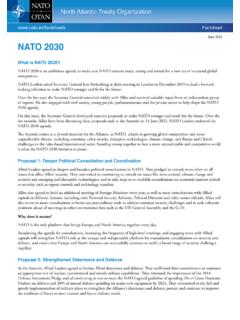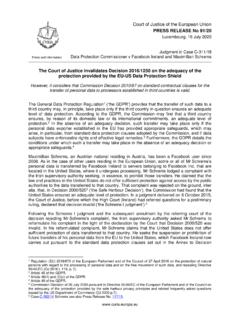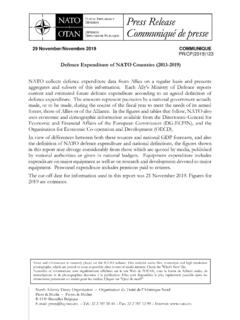Transcription of COMMUNICATION FROM THE COMMISSION TO THE …
1 european . COMMISSION . Strasbourg, COM(2022) 61 final COMMUNICATION FROM THE COMMISSION TO THE european . PARLIAMENT, THE COUNCIL, THE european ECONOMIC AND SOCIAL. COMMITTEE AND THE COMMITTEE OF THE REGIONS. Roadmap on critical technologies for security and defence EN EN. 1. Introduction Remaining at the cutting edge of technological development is critical for ensuring Europe's prosperity, security and way of life. New technologies are transforming the security and defence sectors at a faster pace than ever before and blurring the dividing line between the civilian and military domain. Digital technologies in particular are affecting established balances of power within the global security landscape. It is thus essential to ensure that Europe's security and defence sectors remain technologically fit for purpose.
2 Many critical technologies for security and defence increasingly originate in the civilian domain and use critical components of a dual-use nature. To accelerate innovation across domains and foster technological sovereignty in the security and defence sectors, better exchange between civilian and defence research and innovation communities is needed. In light of its longstanding expertise in civilian technological development and its new defence cooperation instruments1, the EU is well placed to take a lead role. However, this will require a more efficient use of resources and a readiness to explore the opportunities of dual use, while upholding the EU's fundamental values. It also means reducing strategic dependencies and vulnerabilities of the value and supply chains associated with these technologies.
3 The fragmentation of Europe's security and defence capabilities has led to economic inefficiencies, reduced operational capacity and increased strategic dependencies. The ongoing revolution in security and defence technologies and the new EU defence cooperation instruments give the EU an opportunity to avoid the mistakes of the past, to build on its existing capacities and preserve its economic prosperity and security. The future european security and defence technological and innovation landscape should be developed under EU cooperative frameworks from the outset. In her 2021 State of the Union address2, President von der Leyen recognised that while work on developing a european defence ecosystem had started, a european defence Union was needed. The EU Strategic Compass for security and defence ( Strategic Compass'), to be adopted by Member States in March 2022, will set out a common strategic vision for the next decade and outline how the EU will enhance its capacity to act and respond to various crises and challenges.
4 Secure its interests and protect its citizens; invest and innovate to jointly develop the necessary capabilities and technologies; and deepen partnerships based on EU values and interests. This roadmap on critical technologies for security and defence responds to a request from the european Council of 25-26 February 20213 to outline a path for boosting research, technology development and innovation (RTD&I) and reducing the EU's strategic dependencies in critical technologies and value chains for security and defence . The roadmap will be presented to the informal summit in Paris on 10-11 March 2022 and will feed into the Strategic Compass. The 1. The european defence Fund (EDF), the Coordinated Annual Review on defence (CARD) and the Permanent Structured Cooperation on defence (PESCO).
5 2. 2021 State of the Union address of COMMISSION President von der Leyen 3. Statement of the members of the european Council of 26 February 2021. 1. Roadmap proposes a way forward for the EU and Member States to jointly reach the above- mentioned goal, notably by: identifying technologies critical for EU security and defence , boosting them through european (RTD&I) programmes;. ensuring that defence considerations are better taken into account in civilian european RTD&I programmes and industrial and trade policies, as appropriate, while possible civilian uses of technologies are also better considered in defence RTD&I programmes;. promoting from the outset an EU-wide strategic and coordinated approach for critical technologies for security and defence , to make the best use of EU and Member States'.
6 RTD&I programmes, achieve synergies between civilian and defence RTD&I communities and mitigate strategic dependencies from external sources; and coordinating as much as possible with other like-minded partners, such as the United States and the North Atlantic Treaty Organization (NATO), under mutually beneficial conditions. 2. Critical technologies and strategic dependencies for security and defence The update of the 2020 New Industrial Strategy: Building a stronger Single Market for Europe's recovery' ( updated industrial strategy')4 of May 2021 confirms that technological leadership remains an essential driver of the EU's competitiveness and innovation, in particular for so- called critical technologies'5. It also underlines the importance of identifying and mitigating strategic dependencies in sensitive ecosystems', including those of proximity, social economy and civil security' and aerospace and defence ', to ensure the EU's resilience.
7 The COMMISSION action plan on synergies between civil, defence and space industries ( synergies action plan')6 of February 2021 recognises the growing importance of disruptive and enabling technologies originating in the civilian domain for Europe's future security and defence and the need to promote cross-fertilisation and synergies between civilian and defence technologies. It sets out several key actions to encourage the exchange of information and cooperation between civilian and defence communities using EU RTD&I programmes and instruments as a starting point. The specific features of the security and defence sectors The EU defence industry has a diverse structure, with large multinationals and small to medium- sized players. Demand comes almost exclusively from national governments, which also control all acquisition of defence -related products and technologies, as well as their export.
8 Different national requirements and national public spending and investment continue to fragment the EU. defence market, at times risking to impede interoperability between Member States' national armed forces. The defence sector therefore does not follow the conventional rules and business models that govern more traditional markets, and has thus limited room to influence related 4. COM(2021) 350 final 5. The COMMISSION in the context of its work on the Observatory of critical technologies is in the process of defining criticality' for the purposes of space, defence and related civil sectors (including security). 6. COM(2021) 70 final 2. investments and market choices. This makes it difficult for industry to undertake substantial self- funded defence RTD&I projects. The EU security industry faces similar challenges, as markets are also predominantly national but even more fragmented.
9 Its customers are diverse ( police forces, internal security agencies, custom agencies, border authorities, private security services), activities take place at different levels (local, regional, national), and organisation varies from one Member State to another. The COMMISSION will present a study on the EU security market in 2022 providing further insights into this complex sector. In addition, COMMISSION services in the first half of 2022 will summarise the proposals for fostering the adoption of capability-driven approaches to be applied across security sectors. These proposals will strengthen the early and forward-looking identification of needs and solutions for security and law enforcement. The space and cyber are strategic enablers' for the security and defence sectors.
10 The space sector shares many of their specific features, with its small market volumes and limited leverage on the private market for components. The resilience of the space programmes and of the space value chains are critical for the EU security and defence objectives. Cyber also plays an increasingly important role across defence capabilities, requiring attention and investment. With fast-increasing cyber-attacks targeting both civilian and defence assets and networks, and the growing role of the civilian sector in cyber innovation and standardisation, closer links between cybersecurity and cyber defence are needed. The COMMISSION contribution to european defence in the context of the Strategic Compass ( defence COMMUNICATION '), which is part of this defence package, outlines further measures for these two sectors.

















